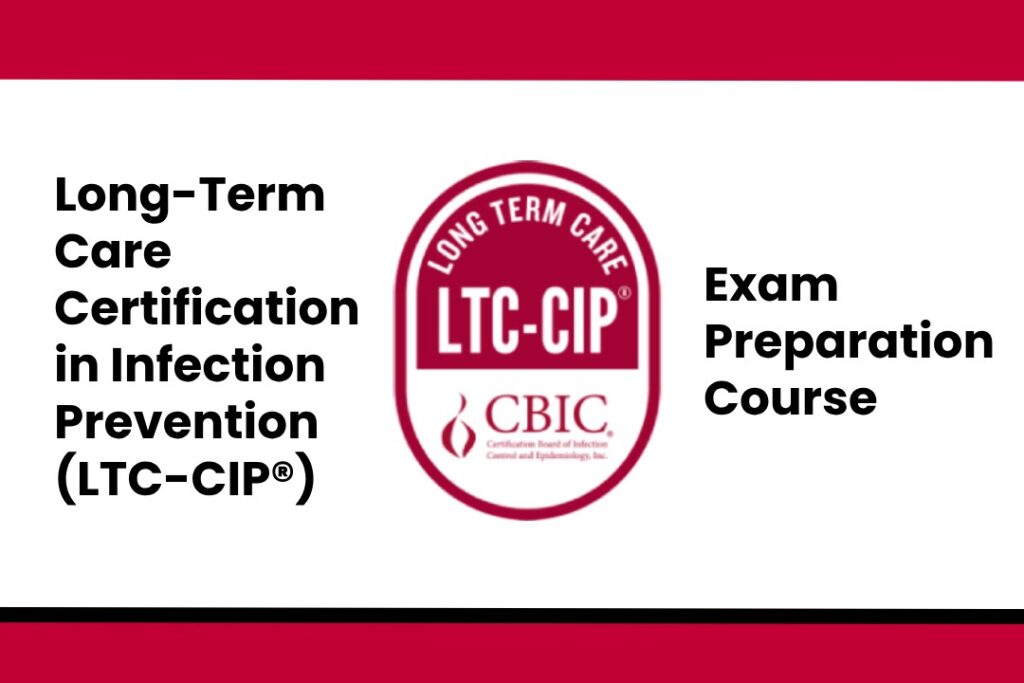Long-Term Care Certification in Infection Prevention (LTC-CIP®)
Course Instructor: Dr. Eta Ashu

$1319 $2500
This course includes:
- Certificate of completion
- Access on mobile and PC
- 24/7 Learner Support
- Full lifetime access
You are Not enrolled
You are not enrolled and do not have access to this Course. Click the button below to enroll.
Course Description

About the Long-Term Care Certification in Infection Prevention (LTC-CIP®)
The LTC-CIP® provides a standardized measure of the basic knowledge, skills and abilities expected of professionals working in the field.
The field include settings that provide a variety of services, including both medical and personal care to people who are unable to live independently. Examples of long-term care settings include:
- nursing homes
- skilled nursing facilities
- assisted living facilities
The LTC-CIP® certification is an objective, multiple-choice examination consisting of 150 questions. 135 of these questions are used to compute the score.
The exam has the following structure:
Introduction & Tutorial: 10 Minutes
Section 1: 90 Minutes
Candidate Break: 16 Minutes
Section 2: 90 Minutes
Survey: 5 Minutes
Exam options
Individuals have the option to schedule to take the examination at a Prometric testing center or Prometric’s remote testing system, ProProctorTM. The list of primary and secondary references used to develop the exam are now available under Exam Prep Resources.
Candidates can learn more about how the examination is written by reading the Practice Analysis and reviewing the content outline.
Important Updates:
New! Effective January 2, 2025, the LTC-CIP® examinations will be delivered using forward navigation. Forward navigation in an examination refers to a format where candidates can only progress through the exam in a linear sequence, answering each question one after another without the option to return to previous questions. Beginning January 2, 2025, candidates must answer all items in the order they appear, with no option to skip questions. Once a candidate confirms an answer and moves to the next question, they cannot go back to change or modify their response. Candidates will no longer be permitted to flag questions or return to previous questions. The text highlight and underline tool will still be permitted. The forward-only exam navigation aligns with the best practices of many healthcare examinations and meets the standards of our accrediting body. Additionally, it serves as a security measure for CBIC examinations.
LTC-CIP®, Examination Scoring
For the LTC-CIP®, Examination, there is one reported pass/fail decision score. A candidate needs a total test scaled score of at least 700 to pass the LTC-CIP®, Examination. Scaled scores are determined by converting the number of questions answered correctly to a scaled score that ranges from 300 to 900. Scaled scores provide a uniform frame of reference, based on the standard adopted by CBIC of the amount of knowledge necessary to pass, without regard to the specific examination form or version taken.
Passing candidates will receive a Pass message. No numerical scaled score is reported to passing candidates. A Pass message indicates that the candidate has mastered the required knowledge for this examination. Failing candidates will receive a scaled score between 300 and 699. A numerical score indicates that the candidate has failed this examination.
Please note that a scaled score is neither the number of questions answered correctly, nor the percentage of questions answered correctly. Scoring specific questions are available on the FAQ site.
Eligibility Guidelines for the LTC-CIP®
**Review the eligibility guidelines page for additional information.**
Candidates will be required to submit the following documentation with their application:
- $410 examination application fee. CBIC Examination Fees increase effective January 6, 2025.
- To apply, please use the following link: https://secure.cbic.org/iMISCBIC/cbic/ltcip-application/
Application Instructions
Step-by-step instructions on how to apply are available here.
- Create a login and password.
- New Users: Follow this link to create a login and password: https://secure.cbic.org/imiscbic/cbic/create-account.aspx You will need an active email address to proceed.
- Returning Users: For those who already have a CBIC login, follow this link to either sign-in to your profile or to reset your login and password: https://secure.cbic.org/imiscbic/cbic/profile/
2. Fill out an application.
- Apply online
LTC-CIP Exam contents
1. Long-Term Care Settings (14 questions)
a. Ethics
1. Basic ethical principles
2. Resident rights and hierarchy of practices for isolation precautions (e.g., precautions are used in the least restrictive way, resident privacy)
b. Communal Gatherings
1. Impact of interaction on psychosocial well-being
2. Infection risk associated with communal gatherings
c. Interdisciplinary Team
1. Infection risk associated with facility and care team demographics (e.g., staff composition, visitors, contracted staff, staffing turnover, ratio of licensed and unlicensed caregivers)
d. Normal Aging Processes
1. Physiology and immune system changes throughout the lifespan
2. Pathophysiology and the disease process (e.g., urinary tract, respiratory, skin and soft tissue, gastrointestinal, bloodborne, viral illnesses)
e. Special Populations
1. Infection risks of complex populations (e.g., residents with medical devices, on dialysis, who need memory support, have cognitive impairment, are on respite or hospice care)
2. Management and Communication of the Infection Prevention Program (15 questions)
a. Infection Prevention Plan
1. Components of an infection prevention plan (e.g., regulatory and advisory requirements, facility demographics)
2. Emergency preparedness (e.g., mitigation, preparedness, response, recovery)
3. Risk assessments (e.g., how to complete and incorporate into plan)
b. Policies and Procedures
1. Best practices per regulatory and advisory agencies
2. Implementation science (e.g., key stakeholders, staff buy-in, dissemination, accessibility, feasibility)
c. Education and Training
1. Adult learning principles (e.g., communication techniques, just-in-time training, in-services)
2. Competency assessment (e.g., return demonstration, post tests, auditing)
d. Research
1. Literature review process
2. Research study design (e.g., peer reviewed, experimental vs. non-experimental, qualitative vs. quantitative)
3. Basic statistics (e.g., p value, confidence interval, appropriateness of test)
e. Quality Assurance and Performance Improvement
1. Performance improvement concepts (e.g., Failure Mode and Effects Analysis [FMEA], Plan Do Study Act [PDSA], Root Cause Analysis [RCA])
2. Performance indicators to achieve key outcomes
3. Culture of safety (e.g., reduce Healthcare-Associated Infections [HAIs], hand hygiene champions)
4. Product and process evaluation (e.g., cost benefit assessments, efficacy studies, standardization of products and processes)
f. Leadership
1. Leadership styles and principles
2. Professional development (e.g., seek knowledge, certifications, continuing education courses)
3. Identification of Infectious Diseases (16 questions)
a. Clinical Signs, Symptoms, and Risk Factors to Identify Possible Infectious Diseases
1. Clinical signs, symptoms, and risk factors to identify possible infectious diseases
b. Diagnostic, Radiologic, Procedural, and Laboratory Reports
1. Interpretation of diagnostic, radiologic, procedural, and laboratory reports (e.g., chest x-ray reports, culture and sensitivity)
c. Specimen Collection, Transportation, Handling, and Storage
1. Methods of specimen collection, transportation, handling, and storage
d. Basic Microbiology
1. Basic microbiology terminology (e.g., bacteria, virus, Gram stain)
2. Microbial pathogenicity and host response
e. Epidemiologically Significant Organisms
1. Epidemiologically significant organisms, including Multidrug Resistant Organisms (MDROs) (e.g., susceptibility pattern interpretation)
2. Appropriate interventions (e.g., precautions, appropriateness of antimicrobial selection)
4. Surveillance and Epidemiologic Investigation (22 questions)
a. General Principles of Epidemiology
1. Basic epidemiology
2. Processes for preventing and mitigating transmission (e.g., cleaning, disinfection, vaccination, transmission-based precautions)
b. Surveillance Design
1. Surveillance methods and purpose (e.g., prospective, retrospective, targeted/priority directed)
2. Collection and compilation of surveillance data
3. Surveillance plan components (e.g., goals and objectives identified from the risk assessment)
c. Outbreak Management
1. Outbreak management concepts (e.g., case definition, period of investigation, case finding methods)
2. Outbreak management steps (e.g., reporting, control measures)
d. Collaboration with Internal and External Agencies
1. Internal organizational structure and culture
2. Public health guidelines for infection prevention
3. Public health resources and agencies for infection prevention
e. Reporting
1. Reporting structure (e.g., internal, governmental, and regulatory agencies)
f. Data Management, Analysis, and, Interpretation
1. Standardized definitions (e.g., surveillance or case definitions)
2. Data analysis (e.g., incidence/prevalence, provider specific, unit specific, device specific, procedure specific)
3. Data collection methods
4. Report preparation and presentation
5. Surveillance driven action plans
5. Prevention and Control of Infectious and Communicable Diseases (22 questions)
a. Hand Hygiene
1. Key elements for a hand hygiene program
b. Standard and Transmission-Based Precautions
1. Standard and transmission-based precautions
2. Injection safety and safe disposal (e.g., multidose vials, IV medication, glucometers, insulin pens)
c. Personal Protective Equipment (PPE)
1. Appropriate use of Personal Protective Equipment (PPE) (e.g., selection, procurement, donning and doffing, point of care risk assessment)
2. Regulatory requirements associated with Personal Protective Equipment (PPE) supplies (e.g., Centers for Medicare and Medicaid Services [CMS], Occupational Safety and Health Administration [OSHA], National Institute for Occupational and Safety Health [NIOSH], Food and Drug Administration [FDA], Health Canada)
d. Food Safety
1. Safe food handling (e.g., regulatory requirements, Hazard Analysis and Critical Control Point [HACCP])
e. Resident Immunizations
1. Immunization recommendations for residents
f. Ancillary Services
1. Infection prevention practices required for ancillary services (e.g., podiatry, dental, environmental services)
6. Environment of Care (16 questions)
a. Environmental Safety
1. Safe care environment (e.g., management of ventilation, water, waste, laundry; environmental cleaning; infestation; pets)
2. Environmental cleaning and disinfection practices and technologies
3. Environmental pathogens (e.g., Legionella, Aspergillus)
b. Construction and Maintenance
1. Infection risks associated with construction and maintenance (e.g., Infection Control Risk Assessment [ICRA])
2. Risk mitigation strategies (e.g., barriers, change air flow, move residents, Personal Protective Equipment [PPE] for maintenance/construction staff)
7. Cleaning, Disinfection, Sterilization of Medical Devices and Equipment (13 questions)
a. Cleaning, Disinfection, and Sterilization Practices
1. Cleaning, disinfection, and sterilization practices based on intended use (e.g., Spaulding classification)
2. Cleaning, disinfection, and sterilization methods (e.g., UV light, autoclave sterilizer, disinfectant solutions)
8. Antimicrobial Stewardship (9 questions)
a. Core Elements of Antimicrobial Stewardship
1. Core elements of antimicrobial stewardship in Long-Term Care
2. Antimicrobial susceptibility (e.g., antibiogram, antimicrobial resistance patterns)
3. Antimicrobials (e.g., prophylactic, empiric, and therapeutic uses of antimicrobials; broad and narrow spectrum)
b. Colonization, Infection, and Contamination
1. Colonization, infection, and contamination
2. Appropriate antimicrobial use (e.g., overuse harm, risks, ability to treat)
3. Diagnostic stewardship (e.g., no urinalysis [UA]/culture asymptomatic resident, standardized Situation Background Assessment Recommendation [SBAR] forms)
9. Employee/Occupational Health (8 questions)
a. Occupational Exposure
1. Occupational exposure, infections, and infectious diseases (e.g., management, treatment, risks)
2. Requirements for compliance with regulatory and advisory agencies (e.g., respiratory protection programs, sharps safety)
b. Fitness for Duty
1. Work restrictions associated with communicable diseases (e.g., exposure, illness, compliance with Personal Protective Equipment [PPE] procedures)
c. Employee Immunizations
1. Immunization recommendations for staff
How to prepare for the example
- Read our study notes
- Try the practice quizzes
- Take the practice exam
- Reach out to IPACmavens instructor on info@ipacmavens.com of you have any questions
Course Content
Course Instructor
Dr. Eta Ashu
- Secure Online Payment

100% No-Risk Money Back Guarantee!
You are fully protected by our 100% Money Back Guarantee. This means that you have zero risk purchasing this course. If you go through a few lessons and don't like it within 7 days, we will refund all your money, no questions asked, in accordance with our refund policy.
Frequently Asked Questions
Response here Lorem ipsum dolor sit amet consectetur adipiscing elit porttitor posuere sagittis aenean ultrices, ullamcorper magnis feugiat dapibus quisque commodo facilisis purus curabitur eros. Congue scelerisque nibh
Response here Lorem ipsum dolor sit amet consectetur adipiscing elit porttitor posuere sagittis aenean ultrices, ullamcorper magnis feugiat dapibus quisque commodo facilisis purus curabitur eros. Congue scelerisque nibh
Response here Lorem ipsum dolor sit amet consectetur adipiscing elit porttitor posuere sagittis aenean ultrices, ullamcorper magnis feugiat dapibus quisque commodo facilisis purus curabitur eros. Congue scelerisque nibh
Response here Lorem ipsum dolor sit amet consectetur adipiscing elit porttitor posuere sagittis aenean ultrices, ullamcorper magnis feugiat dapibus quisque commodo facilisis purus curabitur eros. Congue scelerisque nibh
